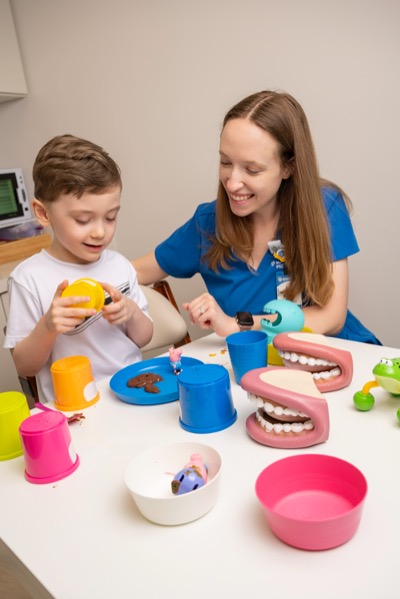Specialist Assistance for Food Aversion Therapy Long Island
Wiki Article
Browsing the Path to Successful Feeding: Ingenious Techniques and Interventions for Effective Feeding Therapy
Are you battling to find reliable methods and treatments for effective feeding therapy? Look no further. This article will certainly guide you with the course to success, giving innovative strategies to examine feeding challenges and established achievable objectives. With evidence-based strategies, you'll learn just how to deal with sensory handling problems and utilize assistive modern technology and flexible devices. And also, we'll reveal you the value of collaborating with households and caretakers for optimum feeding end results. Prepare to navigate the path to effective feeding!Assessing Feeding Obstacles and Identifying Goals
You must start by evaluating your kid's feeding difficulties and determining details objectives for their treatment. This step is important in establishing an effective feeding therapy plan. Begin by observing your youngster's feeding actions and patterns. Look for any aversions or difficulties they may have in the direction of specific foods or textures. Remember of any kind of physical or sensory issues that may be affecting their ability to consume. As soon as you have actually determined these challenges, you can after that establish certain goals for their therapy. These objectives ought to be possible and sensible, concentrating on boosting your kid's feeding skills and total nutrition. You may set a goal for your kid to be able to endure a larger range of appearances or to self-feed with utensils. It is very important to interact these objectives with your child's feeding specialist so they can tailor the treatment sessions to deal with these specific obstacles. By examining your child's feeding difficulties and establishing goals, you are taking the first action towards helping them develop effective feeding skills.Applying Evidence-Based Techniques for Feeding Therapy
Carrying out evidence-based approaches for feeding therapy can bring about positive outcomes for children. You are making certain that the interventions used are supported by scientific research study and have actually been confirmed reliable when you include these strategies into your kid's therapy plan. This method boosts the likelihood of success and helps deal with the certain feeding challenges your youngster might be experiencing.By following evidence-based methods, you can provide your youngster with the best possible treatment and assistance. These methods might include using a variety of sensory experiences throughout nourishments, such as checking out different appearances and tastes, to motivate acceptance of new foods. In addition, implementing therapy strategies can assist attend to choosy eating habits and promote healthier eating patterns.
One more important element of evidence-based feeding treatment is entailing the family in the treatment procedure. By giving education and assistance to moms and dads and caretakers, they can play an energetic duty in assisting their child get over feeding difficulties. This collective technique boosts the efficiency of therapy and promotes enduring favorable adjustments in your youngster's consuming behaviors.

Dealing With Sensory Processing Issues in Feeding Therapy
Resolving sensory processing problems in feeding therapy can be difficult, however it is essential for advertising a favorable consuming experience for kids. When you experience a child with sensory processing difficulties throughout nourishment, it is vital to recognize that their responses to certain textures, tastes, scents, and even noises are not deliberate (food aversion therapy long island). By recognizing and resolving these problems, you can help develop an encouraging atmosphere that encourages healthy and balanced consuming practices
One effective technique is to introduce brand-new foods slowly. Start with small, non-threatening sections and progressively raise the quantity gradually. This technique permits the youngster to end up being acquainted with the food and its sensory buildings at their very own speed. Furthermore, offering a selection of tastes and structures can aid desensitize their sensory system and broaden their food preferences.
Involving the child in sensory play activities can additionally be valuable. Encourage them to explore different appearances, such as squishing, squeezing, or touching different food things. This can help normalize sensory input and reduce aversions to specific appearances.
Another essential element is providing a calm and structured eating environment. Reduce disturbances, such as brilliant lights or loud sounds, which can bewilder their detects and prevent their ability to focus on eating. Producing a foreseeable routine and utilizing visual routines can additionally aid the youngster really feel more secure and in control during mealtime.

Making Use Of Assistive Modern Technology and Adaptive Tools
Making use of assistive modern technology and adaptive equipment can substantially boost the feeding experience for kids with sensory processing troubles. When you have difficulty with sensory processing, nourishment can be difficult and overwhelming. With the right devices, you can make it a much more successful and pleasurable experience.One choice is utilizing specialized utensils and plates designed to suit your needs. These utensils might have textured handles or a bigger grip, making them less complicated to manipulate and hold. Plates with split areas can help divide Click Here various foods and prevent them from touching, which can be a resource of discomfort for some kids.
Along with specialized plates and tools, there are also assistive gadgets that can be made use of during feeding. A heavy vest or lap pad can provide deep pressure input, assisting to relax and regulate your sensory system. A vibrating tooth brush or chewable fashion jewelry can give oral sensory stimulation, making the act of consuming more satisfying.
Modern technology can likewise play a duty in improving the feeding experience. There are applications and devices available that can offer visual or acoustic cues, such as timers or triggers, to aid you stay focused and organized throughout mealtime.
Teaming Up With Family Members and Caretakers for Successful Feeding Outcomes
When collaborating continue reading this with family members and caretakers, you can work together to create a helpful and nurturing environment for successful feeding outcomes. By entailing families and caregivers in the feeding treatment procedure, you can obtain beneficial understandings right into the youngster's feeding preferences, habits, and challenges. feeding therapy long island. This cooperation enables an all natural technique to feeding therapy, dealing with not only the physical aspects yet additionally the emotional and emotional elements that may impact a child's feeding capacitiesOne trick aspect of working together with family members and caretakers is supplying education and training. By furnishing them with knowledge and skills, they can actively take part in the feeding treatment process and support the child's progression outside of therapy sessions. This can include educating them feeding methods, approaches for taking care of mealtime actions, and recognizing the value of uniformity and regimen in developing healthy consuming habits.
In addition, including family members and caregivers in personal goal setting and treatment preparation ensures that their viewpoints and objectives for the child are thought about. By collaborating, you can develop attainable and sensible goals that line up with the family members's priorities and values - food therapist long island. This joint approach promotes a feeling of possession and empowerment, producing a solid structure for successful feeding results
On top of that, routine and open interaction with family members and caregivers is essential for reliable partnership. By keeping continuous dialogue, you can attend to concerns, give assistance, and make required changes to the feeding treatment strategy as required. This communication also enables for sharing development updates, commemorating success, and identifying any type of difficulties or obstacles that browse around this site might occur.

Verdict
You have checked out numerous techniques and treatments for reliable feeding therapy, such as examining challenges, carrying out evidence-based strategies, attending to sensory handling issues, and using assistive technology. Remember to always remain proactive and ingenious in your strategy to feeding therapy.It's vital to interact these objectives with your kid's feeding therapist so they can customize the therapy sessions to resolve these certain obstacles.Carrying out evidence-based approaches for feeding therapy can lead to positive results for children.Addressing sensory handling problems in feeding treatment can be challenging, yet it is crucial for advertising a positive eating experience for children. By involving households and caregivers in the feeding therapy process, you can acquire useful insights into the kid's feeding difficulties, practices, and preferences. By furnishing them with understanding and abilities, they can actively participate in the feeding treatment procedure and support the child's progression outside of treatment sessions.
Report this wiki page